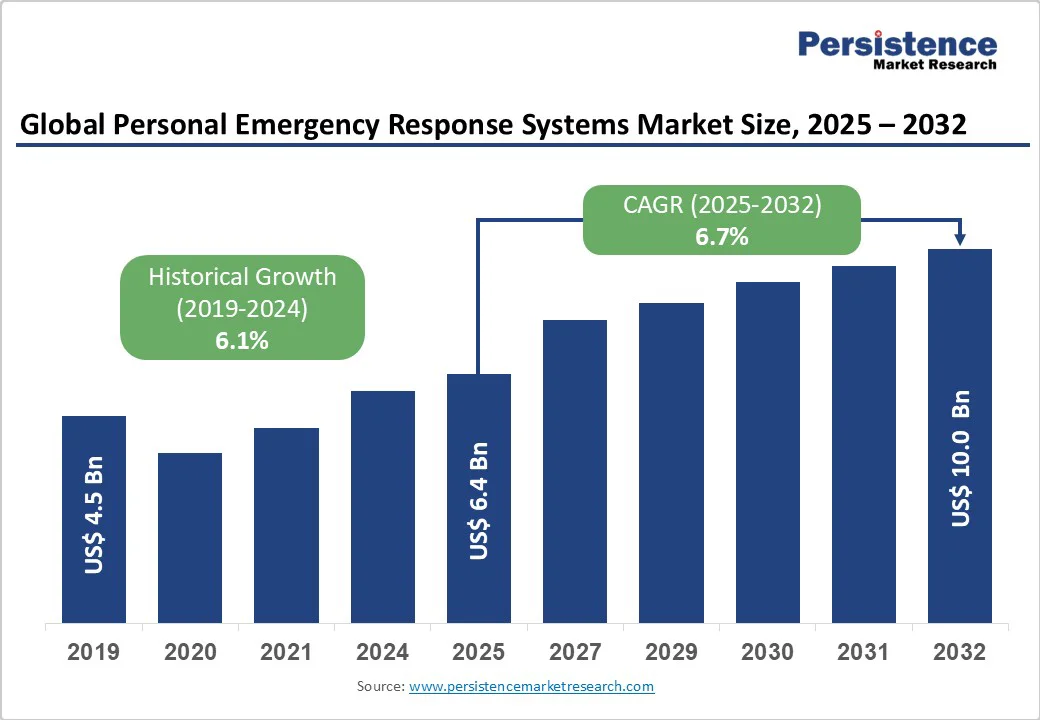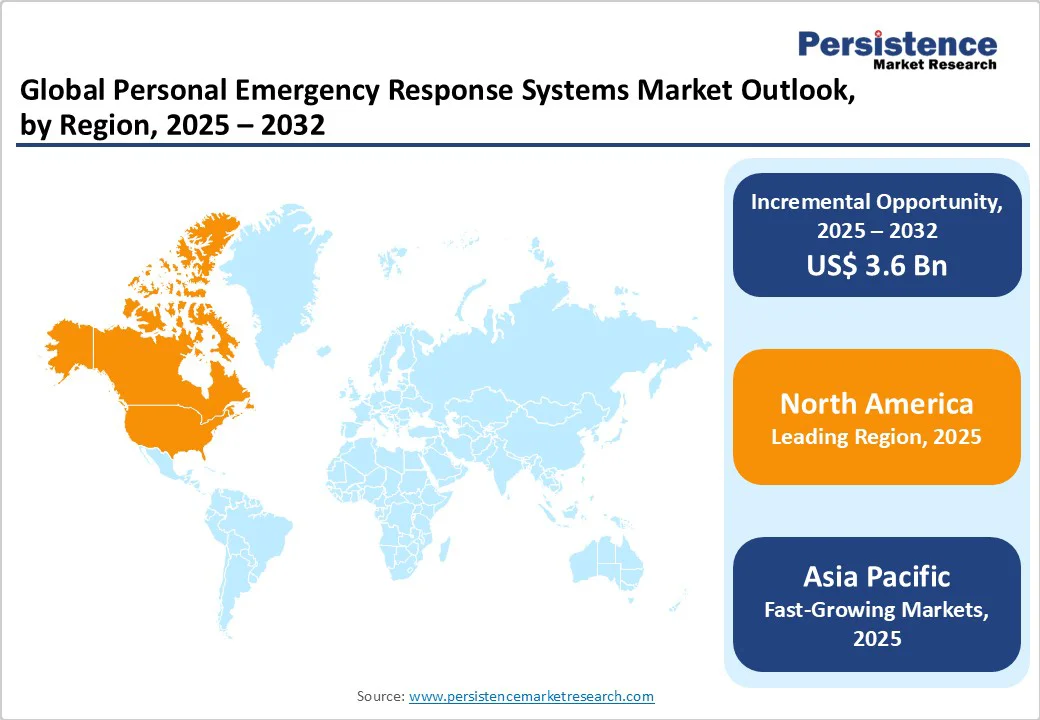ID: PMRREP6403| 183 Pages | 29 Oct 2025 | Format: PDF, Excel, PPT* | Healthcare

The global personal emergency response systems market size is estimated to reach US$ 6.4 billion in 2025 and is projected to reach US$ 10.0 billion by 2032, growing at a CAGR of 6.7% between 2025 and 2032.
Medical alert systems, also known as personal emergency response systems (PERS), encompass devices such as smartwatches, in-home assistants, and two-way communication systems, designed to connect users to emergency personnel when urgent attention is needed.
| Key Insights | Details |
|---|---|
| Global Personal Emergency Response Systems Market Size (2025E) | US$ 6.4 billion |
| Market Value Forecast (2032F) | US$ 10.0 billion |
| Projected Growth (CAGR 2025 to 2032) | 6.7% |
| Historical Market Growth (CAGR 2019 to 2024) | 6.1% |

The personal emergency response systems market is witnessing strong growth driven by technological innovation, smartphone integration, and the growing need for senior safety solutions. Manufacturers are increasingly focusing on developing versatile, mobile, and app-based PERS devices that ensure constant connectivity and independence for aging populations. With over 55 million individuals living with Alzheimer’s globally (WHO, 2024), the demand for accessible and proactive safety solutions is surging.
The rapid adoption of smartphones has enabled the rise of mobile application-based PERS, transforming phones into emergency response tools through on-screen SOS buttons linked directly to 24/7 service centers. Companies are launching smartphone-compatible and wearable devices equipped with wireless communication, GPS tracking, fall detection, and cloud integration, driving global market expansion.
Recent innovations highlight this trend. In January 2024, Kwikset® partnered with FallCall Solutions to integrate the Kwikset Halo Wi-Fi smart lock with FallCall’s medical alert apps, introducing Kwik-Unlock-a feature that automatically unlocks doors for emergency responders, minimizing delays and property damage. Meanwhile, LogicMark’s Freedom Alert Max (November 2024) offers geofencing, fall detection, and video-assisted caregiver monitoring at affordable monthly plans.
In addition, discount programs from Association of Retired Persons (AARP) and the U.S. Department of Veterans Affairs (VA) are making these systems more affordable, further fueling adoption. Together, these innovations and supportive initiatives are redefining PERS as an essential tool for active aging, remote caregiving, and personal safety management worldwide.
The growth of the personal emergency response systems market faces significant restraints, primarily due to high service costs, limited insurance coverage, and accuracy challenges in fall detection technologies. Subscription-based pricing models-often monthly, quarterly, or annual-make PERS less accessible in developing and middle-income nations, where more than 80% of fall-related fatalities occur, particularly across Southeast Asia and the Western Pacific.
According to a 2024 study by The Senior List, only 1 in 10 Americans aged 65 or older currently use medical alert systems, despite one-third reporting falls in the past year. Cost remains a primary deterrent-with 1 in 4 non-users citing affordability concerns.
Average monthly PERS costs range between $19.99 and $49.95, with additional activation, equipment, and installation fees that can exceed $300 upfront. Although some support is available through Medicare Advantage, Medicaid waivers, Veterans Affairs, and long-term care insurance, Medicare Parts A and B do not cover these systems, restricting broader adoption.
Technological limitations also hinder market acceptance. Even the most advanced fall detection systems, with up to 95% accuracy, often fail to identify sliding or gradual falls, leading to delayed emergency responses. These functional gaps, combined with financial constraints and social stigma among seniors, continue to impede the full potential of PERS adoption worldwide.
Rising healthcare expenditure, growing health awareness, and technological convergence are creating new growth opportunities in the personal emergency response systems market. As disposable incomes increase and living standards improve globally, demand for advanced emergency and remote-care solutions is accelerating.
According to the Centers for Medicare & Medicaid Services (CMS), U.S. healthcare spending rose by 7.5% in 2023, reaching $4.9 trillion (or 17.6% of GDP), reflecting a global trend toward greater investment in health infrastructure and preventive technologies.
Innovations in cloud-based monitoring and AI integration are further expanding market potential. In August 2025, FallCall Solutions secured a $1.5 million seed round to launch FallCall Enterprise, a cloud-based medical alert platform designed to enhance community fall monitoring and healthcare provider connectivity.
Earlier, in March 2025, the company partnered with RANiX Co., Ltd. to deploy a radar-based AI system capable of detecting bed-related movement, heart rate, and respiratory rate in real time-reducing hospital fall risks without additional hardware.
Mobile devices are expected to retain the leading share of 47.3% in the global personal emergency response systems market in 2025. These devices provide portability, real-time connectivity, and advanced features such as fall detection, geofencing, and emergency alerts, making them highly suitable for seniors and individuals with chronic conditions.
Unlike traditional landline PERS devices, which have a limited range (300-1,500 feet) and are primarily used in-home or in assisted living facilities, mobile devices allow users to remain connected anywhere. Their ease of use, seamless installation, and compatibility with smartphones and apps make them the preferred choice for enhancing safety, independence, and rapid emergency response.
Homecare settings are projected to remain the leading indication segment in 2025, accounting for 68.8% of the global personal emergency response systems market. The dominance is driven by the growing geriatric population preferring to age in place, relying on PERS devices for immediate assistance during emergencies or health risks.
Unlike assisted living facilities or hospitals, where caregivers are constantly present, home-based users benefit from real-time monitoring and direct connection to response centers. These devices empower seniors and homebound individuals with independence while ensuring rapid medical intervention, making homecare the most critical segment for market growth.

The North America personal emergency response systems market is growing rapidly, projected to capture 42.8% of the global market share by 2025. Growth is driven by a combination of advancing technologies, an increasing geriatric population, and rising prevalence of conditions such as Alzheimer, and other central nervous system disorders, all of which heighten demand for reliable emergency response solutions.
The U.S. Census Bureau estimates that by 2030, the population over 65 will increase by 23.2%, surpassing 20% of the total population, while older adults are projected to outnumber children by 2035, creating a substantial market for senior-focused products.
Fall-related incidents remain a critical concern. Each year, 3 million Americans over 65 seek emergency care due to falls, with one in five sustaining severe injuries, including hip fractures and traumatic brain injuries. Studies indicate that 38% of older adults who fall require assistance to get back up, with 17% waiting over an hour for help, highlighting the importance of PERS devices for timely emergency intervention.
Key initiatives are expanding access and adoption in the U.S. For example, ENDGBV’s Home+ program in New York provides survivors of domestic violence with pendant alarms, reinforced by Local Law 45 in 2024, offering short-term six-month safety support. In October 2023, FallCall Solutions launched the FallCall Pendant in partnership with Essence Smartcare, enabling mobile-connected alerts through Apple Watch, iPhone, and Android devices.
Europe is expected to account for 31.1% of the global share by 2025, driven by increasing adoption across both developed and emerging economies. The United Kingdom is emerging as a key contributor, supported by affordable devices, discount programs, and rising consumer awareness of senior safety solutions. European PERS providers are increasingly integrating digital account management, real-time monitoring, document sharing, and personalized care plans to enhance user experience and operational efficiency.
In January 2025, Ericsson partnered with IBM to implement the Emergency Services Network in Great Britain. This network leverages Ericsson’s core communication infrastructure and mission-critical expertise to connect frontline emergency personnel with real-time data, location tracking, imagery, and public safety information, benefiting over 300,000 personnel. The initiative aligns with the UK government’s Plan for Change, aiming to improve emergency response efficiency and urban safety, while showcasing the potential for PERS integration with broader public safety networks.
Asia Pacific personal emergency response systems market is experiencing rapid growth, with a CAGR of 10.4%, driven by rising adoption of wearable and mobile-connected emergency devices across the region.
In January 2023, FallCall Solutions partnered with HSC Technology Group to introduce iPhone- and Android-based medical alert systems in Australia, integrating next-generation Bluetooth devices with the FallCall app. When a fall is detected, a help call is activated, connecting users to 24/7 response partners nationwide, ensuring timely emergency support.
In April 2023, Trelawear Inc. expanded its stylish Bluetooth PERS pendants to Australia, partnering with the Talius® Care Platform and FallCall Lite app. The discreet pendants allow older adults, particularly women, to “Age in Place” while maintaining independence. If the emergency button is pressed, dozens of response partners are alerted instantly, offering both safety and peace of mind.
The market is also witnessing innovation through IoT-enabled wearables. In July 2024, KORE collaborated with mCare Digital to launch the mCareWatch 241, a wearable personal emergency device that enables virtual monitoring of patients at home or in healthcare facilities, leveraging IoT connectivity and cloud-based provisioning.
Singapore is another notable market, with initiatives supporting large-scale deployment of PERS. In January 2025, the Age Well SG program extended emergency systems to 27,000 seniors in public rental flats. In September 2025, SPTel and iWOW Technology expanded the wireless Alert Alarm System (AAS), utilizing LoRaWAN networks and IoT platforms to connect residents to a 24/7 emergency hotline.
Furthermore, the Singapore Cell Broadcast System, announced in August 2025, to enable location-based emergency alerts on mobile phones, enhancing public safety and rapid response capabilities across the country. Collectively, these technological advancements, mobile connectivity, and government-supported deployments are driving robust growth of the Asia Pacific PERS market.

The personal emergency response system market is evolving with advanced, user-friendly wearable devices offering real-time fall detection, geofencing, emergency video, and continuous connectivity, enhancing safety, independence, and proactive health support for seniors and at-risk individuals.
The global personal emergency response systems market is projected to be valued at US$ 6.4 billion in 2025.
Rising aging population, increasing health awareness, and adoption of connected, wearable PERS devices drives the global market.
The global market is poised to witness a CAGR of 6.7% between 2025 and 2032.
Expansion of IoT-enabled, app-based PERS solutions and growing healthcare funding in emerging regions offer lucrative opportunities.
Major players in the global personal emergency response systems market are ADT, ClearArch, Inc., LogicMark, Lifeline, Medical Guardian, Connect America and others.
| Report Attribute | Details |
|---|---|
| Historical Data/Actuals | 2019 - 2024 |
| Forecast Period | 2025 - 2032 |
| Market Analysis | Value: US$ Mn, Volume (Units) |
| Geographical Coverage |
|
| Segmental Coverage |
|
| Competitive Analysis |
|
| Report Highlights |
|
By Product
By End-user
By Region
Delivery Timelines
For more information on this report and its delivery timelines please get in touch with our sales team.
About Author